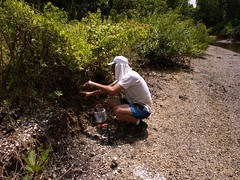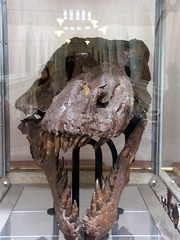 Hello everyone, and apologies, again, for the long lapse between postings. Summer tends to be a busy time for researchers, what with field work, attending conferences, presenting at conferences, and so on. I recently returned from a workshop at the NMNH (National Museum of Natural History, Smithsonian Institution) and thought that I would share some thoughts with you. This was a meeting of the long-running ETE (Evolution of Terrestrial Ecosystems) group. The topic of this meeting was the role of scale in paleoecology, meaning temporal and spatial scales. There were about 30 invited paleoecologists, including colleagues from Europe, and experts in terrestrial and marine ecosystems, plants, vertebrates and invertebrates, etc. I was there mostly, I think, as a member of the small group of theoretical paleobiologists. We covered a lot of ground in four days, focusing on the relationship between present-day ecology (neoecology), and the ecology of past ecosystems. A couple of key questions and points that were raised, and should be of interest to you readers, include:
Hello everyone, and apologies, again, for the long lapse between postings. Summer tends to be a busy time for researchers, what with field work, attending conferences, presenting at conferences, and so on. I recently returned from a workshop at the NMNH (National Museum of Natural History, Smithsonian Institution) and thought that I would share some thoughts with you. This was a meeting of the long-running ETE (Evolution of Terrestrial Ecosystems) group. The topic of this meeting was the role of scale in paleoecology, meaning temporal and spatial scales. There were about 30 invited paleoecologists, including colleagues from Europe, and experts in terrestrial and marine ecosystems, plants, vertebrates and invertebrates, etc. I was there mostly, I think, as a member of the small group of theoretical paleobiologists. We covered a lot of ground in four days, focusing on the relationship between present-day ecology (neoecology), and the ecology of past ecosystems. A couple of key questions and points that were raised, and should be of interest to you readers, include:
- How do the short-term processes of ecology, such as predation and competition, scale over longer time scales? This question is of great importance because as we extend the time scale beyond the typical life-spans of organisms, processes of evolutionary change and geophysical variation become increasingly important. For example, many climate variables such as rainfall quasi cycles and Milankovitch cycles vary on decadal and millennial time scales. The changes in climate in turn will act as agents of natural selection on the organisms.
- Does the structure of ecological communities and ecosystems constrain the manner in which members of those communities are able to adapt to changing conditions? In other words, can the ways in which a species interacts with other species, the number of such interactions, etc., limit the ability of the species to adapt to change? This should interest you readers greatly because of the common assumption that somehow organisms will adapt to climate change in ways that are easy to predict based on short-term observations of those organisms. This question is getting at the possibility that knowledge of the individual environmental tolerances of a species, e.g. its preferred temperature range, will not necessarily allow us to predict how that range will change as global temperature increases.
- Finally, is the past a key to the future? Paleontologists are fond of saying that the past is the key to the present, meaning that historical narratives often explain why things are the way that they are today. But given our feeling that short-term observations omit the behaviour of complex systems, such as communities, on longer time scales, then knowledge of the past should also be critical to any predictions that we make of the behaviour of those systems into the future. And prediction, of course, is something that we would dearly love to nail down when it comes to climate change.
In my next posting we will get back to the CEG model, because my recent work suggests that it could be extended to analyze and predict the evolutionary responses of species in the network. This is pretty exciting, and I will try to share with you exactly what I am doing, and how I am doing it. And, as with all scientific hypotheses, this one will turn out either as a grand success, or a colossal failure. I am, of course, rooting for the former!
Powered by ScribeFire.
